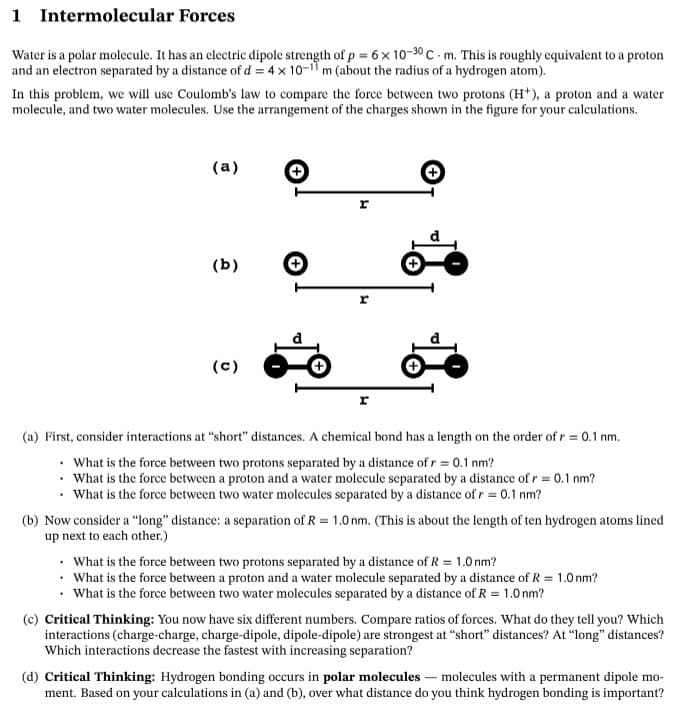Water is a polar molecule. It has an clectric dipole strength of p 6x 10-30 C m. This is roughly cquivalent to a proton and an electron separated by a distance of d = 4 x 10-11 m (about the radius of a hydrogen atom). In this problem, we will use Coulomb's law to compare the force between two protons (H*), a proton and a water molecule, and two water molecules. Use the arrangement of the charges shown in the figure for your calculations. (a) (b) (c) r (a) First, consider interactions at "short" distances. A chemical bond has a length on the order of r 0.1 nm. • What is the force between two protons separated by a distance of r 0.1 nm? What is the force between a proton and a water molecule separated by a distance of r 0.1 nm? What is the force between two water molecules separated by a distance of r = 0.1 nm?
Water is a polar molecule. It has an clectric dipole strength of p 6x 10-30 C m. This is roughly cquivalent to a proton and an electron separated by a distance of d = 4 x 10-11 m (about the radius of a hydrogen atom). In this problem, we will use Coulomb's law to compare the force between two protons (H*), a proton and a water molecule, and two water molecules. Use the arrangement of the charges shown in the figure for your calculations. (a) (b) (c) r (a) First, consider interactions at "short" distances. A chemical bond has a length on the order of r 0.1 nm. • What is the force between two protons separated by a distance of r 0.1 nm? What is the force between a proton and a water molecule separated by a distance of r 0.1 nm? What is the force between two water molecules separated by a distance of r = 0.1 nm?
Chapter10: Liquids And Solids
Section: Chapter Questions
Problem 1RQ: What are intermolecular forces? How do they differ from intramolecular forces? What are...
Related questions
Question
100%

Transcribed Image Text:1 Intermolecular Forces
Water is a polar molecule. It has an electric dipole strength of p = 6 x 10-30 C - m. This is roughly equivalent to a proton
and an electron separated by a distance of d = 4 x 10-11 m (about the radius of a hydrogen atom).
In this problem, we will use Coulomb's law to compare the force between two protons (H*), a proton and a water
molecule, and two water molecules. Use the arrangement of the charges shown in the figure for your calculations.
(a)
r
(b)
(c)
r
(a) First, consider interactions at "short" distances. A chemical bond has a length on the order of r = 0.1 nm.
• What is the force between two protons separated by a distance of r = 0.1 nm?
• What is the force between a proton and a water molecule separated by a distance of r = 0.1 nm?
What is the force between two water molecules separated by a distance of r = 0.1 nm?
(b) Now consider a "long" distance: a separation of R = 1.0 nm. (This is about the length of ten hydrogen atoms lined
up next to each other.)
• What is the force between two protons separated by a distance of R = 1.0 nm?
• What is the force between a proton and a water molecule separated by a distance of R = 1.0 nm?
What is the force between two water molecules separated by a distance of R = 1.0 nm?
(c) Critical Thinking: You now have six different numbers. Compare ratios of forces. What do they tell you? Which
interactions (charge-charge, charge-dipole, dipole-dipole) are strongest at "short" distances? At "long" distances?
Which interactions decrease the fastest with increasing separation?
(d) Critical Thinking: Hydrogen bonding occurs in polar molecules – molecules with a permanent dipole mo-
ment. Based on your calculations in (a) and (b), over what distance do you think hydrogen bonding is important?
Expert Solution
This question has been solved!
Explore an expertly crafted, step-by-step solution for a thorough understanding of key concepts.
This is a popular solution!
Trending now
This is a popular solution!
Step by step
Solved in 2 steps with 2 images

Knowledge Booster
Learn more about
Need a deep-dive on the concept behind this application? Look no further. Learn more about this topic, chemistry and related others by exploring similar questions and additional content below.Recommended textbooks for you


Chemistry: An Atoms First Approach
Chemistry
ISBN:
9781305079243
Author:
Steven S. Zumdahl, Susan A. Zumdahl
Publisher:
Cengage Learning

Chemistry
Chemistry
ISBN:
9781305957404
Author:
Steven S. Zumdahl, Susan A. Zumdahl, Donald J. DeCoste
Publisher:
Cengage Learning


Chemistry: An Atoms First Approach
Chemistry
ISBN:
9781305079243
Author:
Steven S. Zumdahl, Susan A. Zumdahl
Publisher:
Cengage Learning

Chemistry
Chemistry
ISBN:
9781305957404
Author:
Steven S. Zumdahl, Susan A. Zumdahl, Donald J. DeCoste
Publisher:
Cengage Learning

Introductory Chemistry: A Foundation
Chemistry
ISBN:
9781337399425
Author:
Steven S. Zumdahl, Donald J. DeCoste
Publisher:
Cengage Learning

Chemistry: Principles and Reactions
Chemistry
ISBN:
9781305079373
Author:
William L. Masterton, Cecile N. Hurley
Publisher:
Cengage Learning

Chemistry & Chemical Reactivity
Chemistry
ISBN:
9781337399074
Author:
John C. Kotz, Paul M. Treichel, John Townsend, David Treichel
Publisher:
Cengage Learning